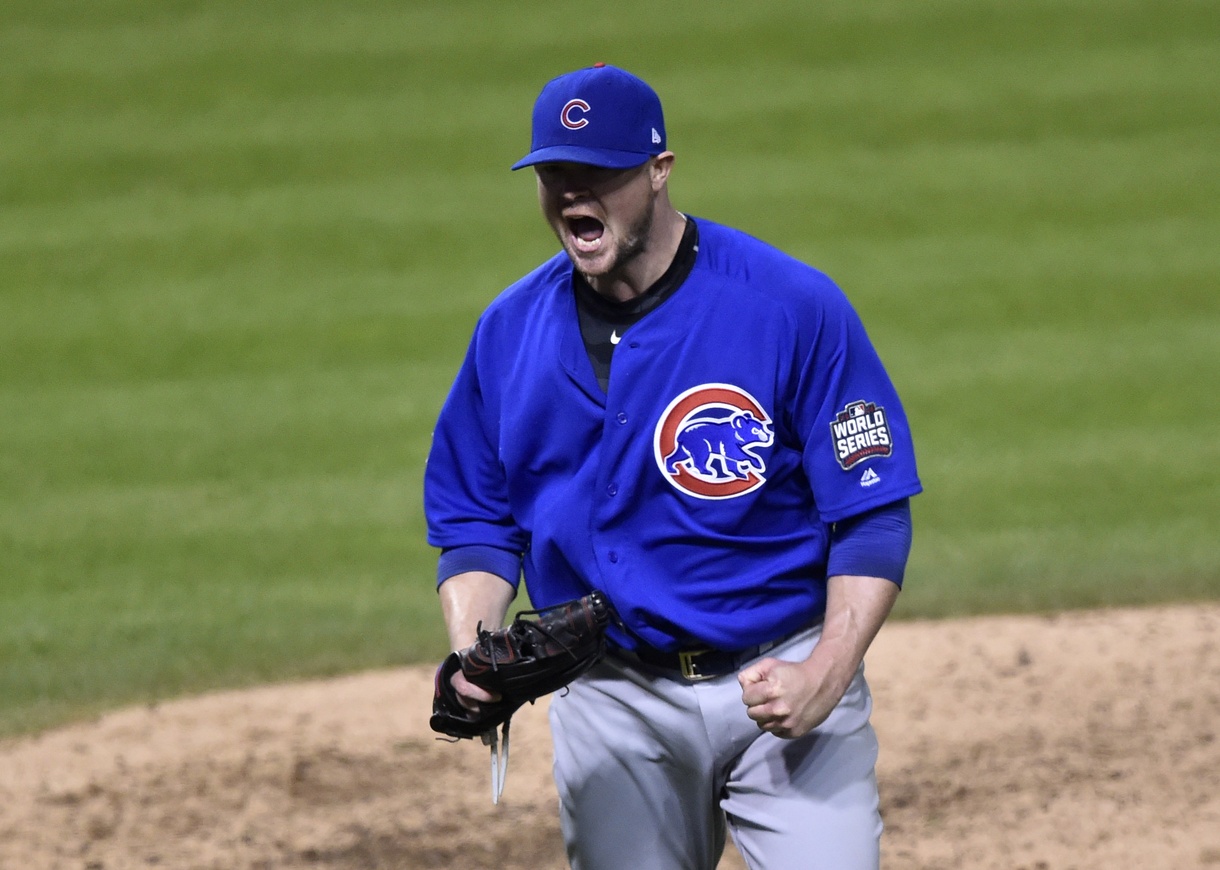Position: Starting pitcher
2016 Stats: 202.7 IP, 24.8 K%, 6.5 BB%, 2.44 ERA, 3.10 DRA, 90 cFIP, 5.3 WARP
Year in Review:
What more could you ask of Jon Lester in 2016? One more literal glove flip? Another walk-off squeeze bunt? A less nerve-wracking Game 7 relief appearance, ideally not featuring a wild pitch that brings a runner in to score? The latter would have been especially nice, but you may also recall that the Cubs won that particular game.
In the year the Cubs won it all, year two of his $155 million contract, we all watched Lester dig his heels into the dirt and put forth a dominant showing as the staff ace he was signed to be.
In his usual style, Lester did it fairly quietly, without the assorted, attention-grabbing bells and whistles of some of his rotation-mates. Lester lacks the out-of-nowhere, slingshot trajectory of Kyle Hendricks, lacks the distinctive abrasiveness of John “I didn’t come here for a haircut” Lackey. Everything about Jake Arrieta tends to command attention, even before he decides to take all his clothes off, and, of course, the team at large wasn’t lacking in stars either.
But the other quiet aspect of Lester’s performance is that in terms of several key stats, 2016 wasn’t radically different or better than 2015. Consistency is, after all, one of the things Lester has excelled in on a year-to-year basis. 2015 saw Lester put up a nearly identical 5.4 WARP and K% of 25. His 2015 BB% of 5.7 was slightly better, as was his DRA of 2.85 and cFIP of 82.
The numbers really start to diverge though once you hit BABIP. Lester’s .256 in 2016 is quite the leap from 2015’s .303, and that’s not simple luck—it’s the Cubs’ exceptional defense. Each member of the Cubs’ rotation reaped these benefits and finished the year with a BABIP ranking among the lowest in the league; Jason Hammel, at 13th-lowest, was the only Cubs starter outside the “top” 10.
Lester also stranded runners at an extraordinary rate this season. His major-league best 84.9 left on base percentage stands in stark relief from 71.8% in 2015. LOB% on its own can be something of an odd landscape; on one hand, you have Max Scherzer and Kyle Hendricks ranking third and fourth respectively, and on the other, it’s Ian Kennedy taking the second place spot.
Where the metric really shows for Lester though is in his performances with runners in scoring position, where he was positively steely, limiting opposing batters to just a .167 average and .526 OPS. You can detect the fingerprint of the defense again here, but Lester wielded this as yet another tool available to him by effectively managing batted ball contact and launch angle, playing directly into that collective strength.
He did this steadily, without the peaks and valleys of his 2015 year, and that’s something that doesn’t show up in full-season stats. Year-to-year consistency became month-to-month consistency as Lester settled down in 2016 and embraced his ace role, unruffled by the responsibility of leading a rotation, but also happy to let his teammates take the spotlight.
It all comes back to the team unit for the Cubs and Lester, which is why even in an era of ever-improving defensive independent pitching statistics, it can be difficult knowing just where to draw the line between a pitcher and a historic defense behind him, particularly when the two reached such a level of symbiosis, leaning on each other throughout a very long season.
It’s exactly this challenge that may have cost Lester some Cy Young votes, but given that the long season resulted in the ultimate team prize, it really is hard to ask for anything more.
Looking ahead:
But…this is a recipe for regression, right?
Some regression will occur, certainly, both for Lester alone and at the team level. There’s always an element of the perfect storm for any World Series-winning team, let alone one that performed at such a high level for an entire season, but the floor is still relatively high for 2017.
The Cubs infield that flanked Lester will return in its entirety. While not every bounce or call will go their way, there’s no reason to believe that Cubs pitcher BABIPs have to drop to anything resembling league-average level, even with the injection of Kyle Schwarber and Jon Jay into the outfield scheme. Lester’s LOB% was not only the best in the league in 2016, but one of the best marks in recent decades, so that masterpiece of sequencing will definitely take a hit.
Lester’s effectiveness may once again come down to quiet consistency, a low hum of batter activity throughout the season that pairs perfectly with not only the much-lauded defense, but an offense that looks primed to yet again split run differential wide open.
Of course, you can’t write a profile of Jon Lester without mentioning David Ross, and the effect of Ross’ departure is indeed an unknown that can only be reckoned with come next spring when we see Lester form batteries with Willson Contreras and Miguel Montero. Lester will miss Ross’ pitch-framing skills and game management, and there is something to be said for personal bonds, particularly when, by Lester’s own admission, his level of emotional steadiness has impacted his performance in a Cubs uniform.
I think about this, and then I think about Lester defiantly staring down the Dodgers’ dugout in the NLCS. There’s no reason yet to undersell the southpaw for next year.
Lead photo courtesy David Richard—USA Today Sports

According to Fangraphs, Lester also led the staff in defensive runs saved, actually finishing 6th on the team in that category, with 8.1? A real head-scratcher, to be sure.
Didn’t Lester get out of two bases-loaded no-out jams this year? I wonder how that affected his LOB%.